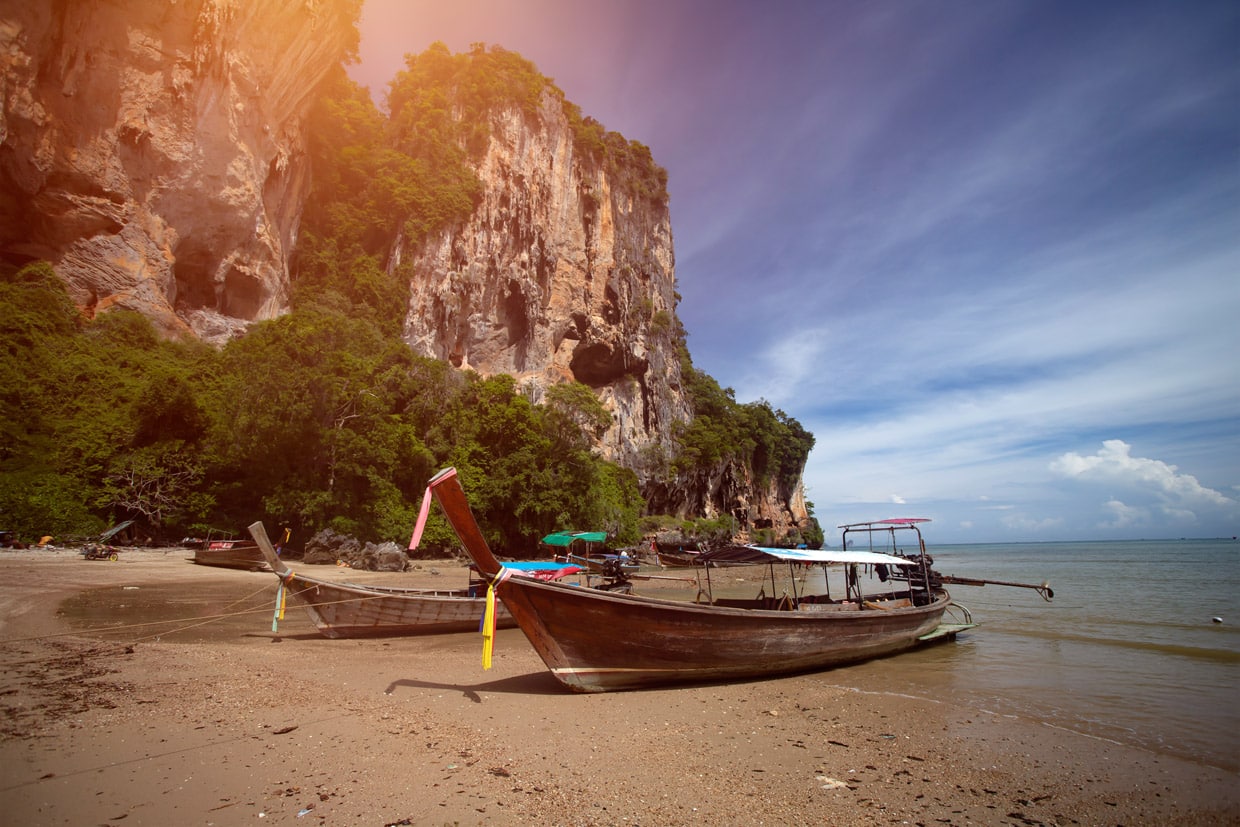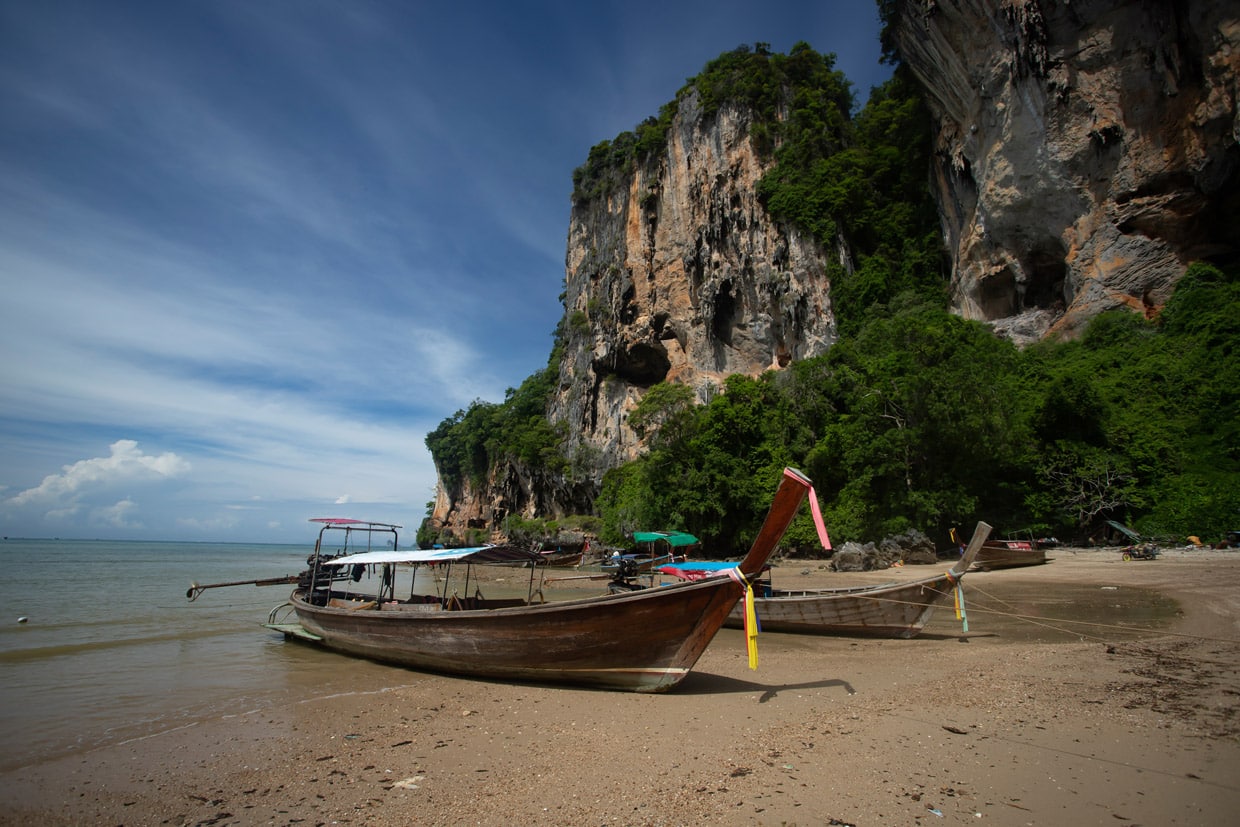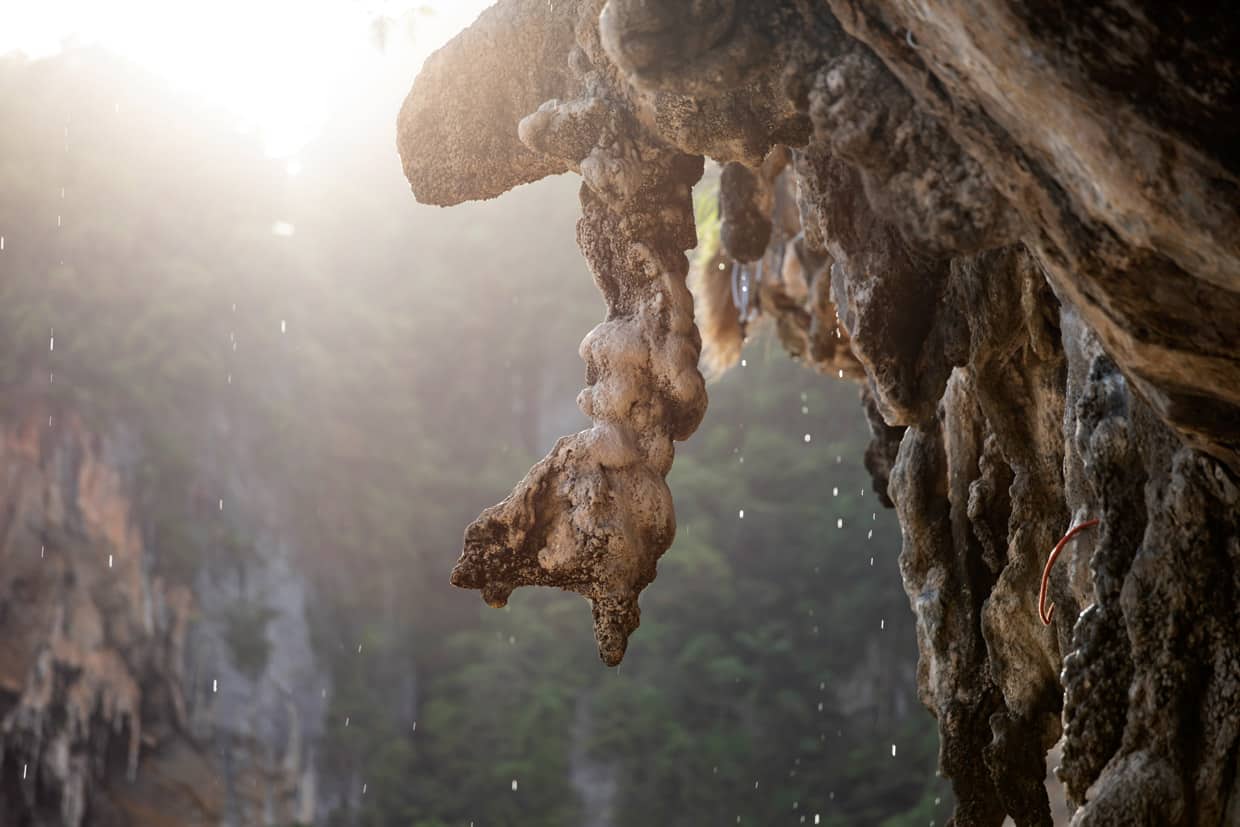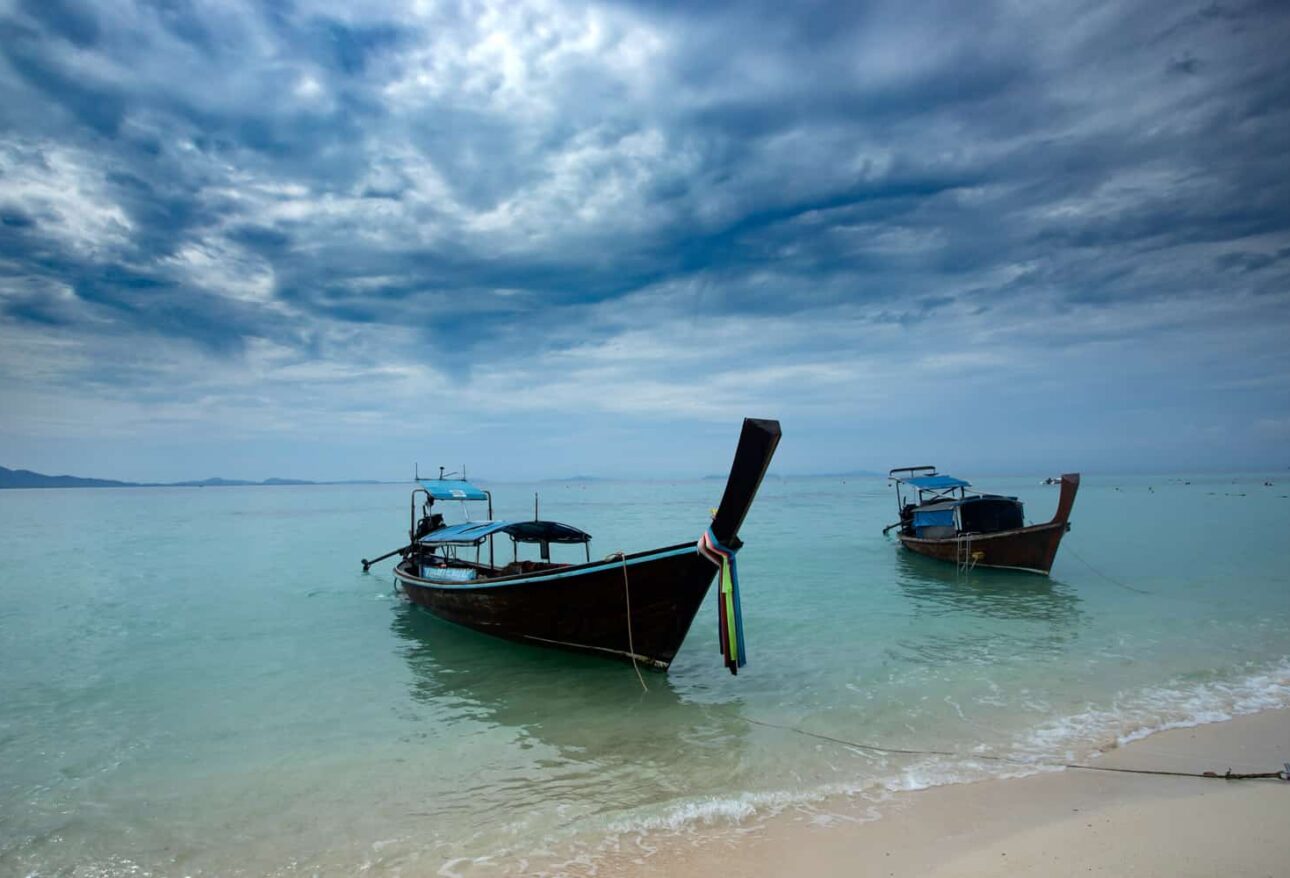In Thailand, Ton Sai Beach is a popular destination for both backpackers and climbers as it offers affordable accommodations and excellent rock climbing routes. It’s rather rough around the edges compared to surrounding Railay and Ao Nang. The beach gets quite rocky, making it unsuitable for swimming and more suitable for rock climbing as the tide goes out. However, Tonsai is mostly famous as a rock climbing destination, even though you can do many “usual” beach activities such as kayaking, swimming, tanning, and so forth.
If you want to solo show up and find a partner, there is no better place in the world than here. The climbing community here is strong and welcoming, attracting an eclectic blend of mountaineers from around the globe.
Accessing Tonsai Beach
Tonsai beach is located in the Krabi province, where you have options for getting there. You can fly directly from some Asian and European countries and some of the cities of Thailand to this region. Check flight timetables for more details.
Phuket and Ao Nang ferries or the minivans from the adjacent locations transfer passengers between these locations. Krabi can also be reached by overnight bus from either Bangkok or Kuala Lumpur. It may be beneficial to check Visa Regulations before planning for the journey.
Ao Nang Beach is a 15-20 minute ride from Krabi . You can take a taxi, van, local bus or a motorbike taxi from Krabi town. To get to Tonsai beach from the city, you have to take a local water taxi called Longtail Boat.

Climate
Climbing at Tonsai Beach is possible most of the time, despite the weather! Although the ideal season supposedly is November through March. The high season is generally characterized by warm, dry days and cool nights. More tourists are in the country during this season, resulting in more expensive accommodation. March to May, the weather is usually scorching and humid, especially between 11 am and 4 pm. However, tourism is on the decline, and the cost of living goes down a little.
By the end of May, the rainy season begins. It may rain every day during this time of year, but that does not necessarily mean it will. The price is much lower, and there are fewer people during this season. The reason many climbers prefer the spring months is because of cooler temperatures and cheaper accommodations. There’s no waiting for routes to become available either.
Remember, weather can be unpredictable, no matter what season! Climate change, coupled with the changing earth’s biome, has resulted in a loss of seasonal predictability. So it is essential to be up to date about the weather, as you plan for the journey and your activities during it.
[wpsm_colortable color=”main-color”]
| January | February | March | April | May | June | July | August | September | October | November | December | |
|---|---|---|---|---|---|---|---|---|---|---|---|---|
| Avg. Temperature °C (°F) |
26.9 °C (80.4) °F |
27.4 °C (81.3) °F |
27.9 °C (82.2) °F |
28.2 °C (82.7) °F |
28.1 °C (82.7) °F |
28.1 °C (82.6) °F |
27.9 °C (82.2) °F |
27.6 °C (81.8) °F |
27.3 °C (81.1) °F |
27 °C (80.6) °F |
27 °C (80.7) °F |
26.9 °C (80.4) °F |
| Min. Temperature °C (°F) |
25.6 °C (78.1) °F |
26 °C (78.7) °F |
26.6 °C (80) °F |
27 °C (80.6) °F |
27 °C (80.6) °F |
27 °C (80.6) °F |
26.8 °C (80.2) °F |
26.6 °C (79.9) °F |
26.2 °C (79.2) °F |
26 °C (78.8) °F |
26 °C (78.8) °F |
25.7 °C (78.3) °F |
| Max. Temperature °C (°F) |
28.5 °C (83.2) °F |
28.9 °C (84.1) °F |
29.1 °C (84.3) °F |
29.2 °C (84.6) °F |
29 °C (84.3) °F |
28.9 °C (84) °F |
28.6 °C (83.6) °F |
28.4 °C (83.1) °F |
28.1 °C (82.6) °F |
27.9 °C (82.3) °F |
28.2 °C (82.7) °F |
28.3 °C (83) °F |
| Precipitation / Rainfall mm (in) |
52 (2) |
24 (0.9) |
79 (3.1) |
137 (5.4) |
267 (10.5) |
234 (9.2) |
239 (9.4) |
264 (10.4) |
303 (11.9) |
299 (11.8) |
215 (8.5) |
96 (3.8) |
| Humidity(%) | 77% | 75% | 77% | 80% | 81% | 81% | 80% | 81% | 82% | 83% | 82% | 79% |
| Rainy days (d) | 5 | 3 | 8 | 14 | 18 | 16 | 17 | 17 | 18 | 20 | 17 | 10 |
[/wpsm_colortable]
The difference between the wettest and driest month is 279 mm | 11 inches. The average temperature varies 1.3 °C | 34.3 °F throughout the year.
Climbing Equipment
Climbing at Tonsai beach needs some equipment. Tonsai has several gear shops. Among the stocks they sell are caulk, quickdraws, carabiners, etc. Since a significant amount has elevated the prices, most people only plan to buy or hire equipment there if they absolutely have to. Bring your own equipment if you plan on a multi-day excursion.
Travel Insurance
Healthcare in Thailand is unlikely to be covered by your home insurance. Daring activities like rock climbing, risk of lost luggage or burglary, and all typical food and water illnesses may cause a need for insurance support. This need is fulfilled by travel insurance.
Many travel insurance plans mention covering “adventure” sports like rock climbing. However, you must read the fine print to find out that they require you to use a certified guide in order to be covered.
Ropes
You can climb every route at Tonsai with a 60m rope. As the harsh salt and tropical climate of Tonsai demands durable ropes, I recommend bringing ropes with double-dry technology. It will help your ropes last much longer and protect them from the weather. Dry ropes prevent salt water from getting into the rope, as well as sand and dirt.
Rope Bag
In Tonsai, you intend to clean your rope off with extra care since sand and dirt can be very damaging. Using a rope bag that works for crag climbing is the best way to go about it. The bag must be big enough to carry ropes and other tools like quickdraws, harnesses, and caulk.
Quickdraws, Harnesses and Climbing Shoes
You will need some common climbing equipment like quickdraws, harnesses, and climbing shoes to climb at Tonsai Beach. These simple items hold your life into their hands; therefore, it is crucial to consider their rate of safety as well as being comfortable and ergonomically designed.
Bug Repellent
In Tonsai, you will encounter mosquitoes, especially once you leave the beaches and proceed inland from the coastal crags. Besides the annoying phenomenon of the mosquito, you need to be aware of the many mosquito-borne diseases found in Thailand, including Dengue Fever.
As a result, it is highly recommended to stock up on non-DEET insect repellent beforehand. This product has the same effect as DEET, but without any drawbacks, since its active ingredient, Picaridin is made from black pepper.

Residence and Facilities
In Tonsai, there are many bungalows to choose from. There are wooden/bamboo bungalows ranging in higher class up until small upscale resorts. However, the prices here are considerably lower compared to Railay and Ao Nang. A majority of bars and bungalows are in the valley’s rear end.
There are many options for entertainment in addition to the bungalows. These include bars, restaurants, trekking shops, massage places, and mini-markets. There is no ATM on Tonsai Beach; however, there are two just a short walk away on Railay Beach. Aside from OneMore and Freedom bars, Small World, Backyard, and Backyard are the most famous bars on Tonsai Beach. Chill-out spots can be very helpful after a day of climbing.

Where to Climb Next
It is about a 20-minute walk toward Railay Beach from Tonsai. A beach with its own share of phenomenal climbs to choose from. Although these two places are so close, the people visiting them are so different.
Railay Beach is mostly filled with beachgoers that are completely content to lie on the sands all day. No problem though, it leaves more climbing space for the enthusiasts. Although the “best” time to climb varies depending on the time of year, most of Railay’s climbs are into the afternoon shade. The pattern of ‘Thai time’ here is quite familiar!





